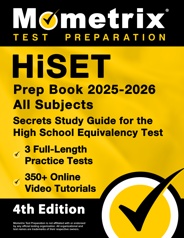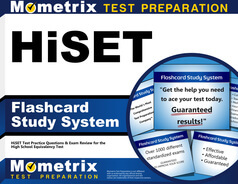Welcome to the HiSET practice test page!
Click the “Start Test” button above to begin our free HiSET practice test! These practice questions will give you a better idea of what to study for your exam.
HiSET Practice Tests by Subject
If you need some extra practice in a specific subject, click one of the subjects below to get started on a subject-specific HiSET practice test.
What is the HiSET?
The HiSET (otherwise known as the ETS High School Equivalency Test) is a standardized test released in the year 2014. It was created by the ITP (Iowa Testing Programs) and ETS (Educational Testing Service).
The HiSET originally spawned as a response to the GED. When the GED’s newest edition released, questions subsequently arose as to how helpful it would be to its target demographic.The HiSET was created alongside another test, the TASC, as a substitute for the GED. Like the GED, the HiSET is meant to help people who failed to graduate from high school and would like to earn their diploma.The HiSET is formatted to evaluate your readiness for a professional or academic environment and tell you where you excel and where you still need to improve.
Benefits of Taking the HiSET
There are some benefits to taking the HiSET as opposed to other similar exams like the GED:
- More Flexible. The HiSET exam is offered in English or Spanish and can be taken on a computer at home with live online proctoring or in a physical testing facility. There is also a paper-based option available for people who require accommodations. For test takers with special needs related to their health or disabilities, the program provides additional accommodations.
- More Accessible. You may take the HiSET examination at any of your state’s or jurisdiction’s existing test centers or at home via the Internet. Test takers are free to select the testing method that best suits their needs.
- More Affordable. The HiSET costs less than other tests, and you can take it twice within a year of when you bought the first sub-test.
Exam Eligibility
Each state has their own specific rules and requirements, so check with your state for details. Regardless of which state you take the exam in, only individuals who are at least 16 years old are eligible to take the HiSET exam, and you must have a state-approved adult education program enrollment and test authorization.
HiSET Outline
The HiSET is split into five sections, which are outlined below.
1. Language Arts – Reading (50 questions)
This section measures your ability to understand, comprehend, interpret, and analyze a variety of reading material. The questions in this section are split into two categories:
- Literary Texts (40%)
- Informational Texts (60%)
You will be given 65 minutes to finish the English version of this section, or you will be given 80 minutes to finish the Spanish version.
2. Language Arts – Writing (61 questions)
This section measures your ability to edit and revise written text and to generate and organize ideas in writing. The questions in this section are all multiple-choice with the exception of one essay question. The multiple-choice questions are split into three categories:
- Organization of Ideas (22%)
- Language Facility (43%)
- Writing Conventions (35%)
The essay question will cover the same categories as the multiple-choice questions and will also assess your ability to develop a central position or claim.
You will be given 2 hours to finish this section.
3. Mathematics (55 questions)
This section assesses your ability to solve quantitative problems using fundamental concepts and reasoning skills. The questions in this section are split into four categories:
- Numbers and Operations (19%)
- Measurement/Geometry (18%)
- Data Analysis, Probability, and Statistics (18%)
- Algebraic Concepts (45%)
You will be given 1.5 hours to finish this section.
4. Science (60 questions)
This section measures your ability to use science content knowledge, apply principles of scientific inquiry, and interpret and evaluate scientific information. The questions in this section are split into three categories:
- Life Science (49%)
- Physical Science (28%)
- Earth Science (23%)
You will be given 80 minutes to finish this section.
5. Social Studies (60 questions)
This section measures your ability to analyze and evaluate various kinds of social studies information. The questions in this section are split into four categories:
- History (35%)
- Civics/Government (35%)
- Economics (20%)
- Geography (10%)
You will be given 70 minutes to finish this section.
Check Out Mometrix's HiSET Study Guide
Get practice questions, video tutorials, and detailed study lessons
Get Your Study Guide
HiSET vs. GED vs. High School Diploma
The HiSET, the GED, and a high school diploma are all credentials widely accepted by colleges and employers, but there are some notable differences among them.
Take a look at the details of each here:
| Time | ||
|---|---|---|
| HiSET | GED | High School Diploma |
| 7 hours (estimated) | 7 hours (estimated) | 4 years (estimated) |
| Question Count | ||
|---|---|---|
| HiSET | GED | High School Diploma |
| 201 (estimated) multiple-choice and essay questions | 156-174 (estimated) | N/A |
| Sections | ||
|---|---|---|
| HiSET | GED | High School Diploma |
| 5 | 4 | 5+ |
| Subjects | ||
|---|---|---|
| HiSET | GED | High School Diploma |
|
|
|
| Prerequisites | ||
|---|---|---|
| HiSET | GED | High School Diploma |
| State-specific |
| Acquiring a certain number of credits per subject |
| Test Dates | ||
|---|---|---|
| HiSET | GED | High School Diploma |
| Year-round | Year-round (based on the testing center) | Via School |
| Registration | ||
|---|---|---|
| HiSET | GED | High School Diploma |
| Online | N/A |
| Fee | ||
|---|---|---|
| HiSET | GED | High School Diploma |
| $50–$100 (state-specific) | $80–$150 (state and format-specific) | Free (for public school students) |
| Fee Waiver | ||
|---|---|---|
| HiSET | GED | High School Diploma |
| Subject to region and area | Subject to region and area | N/A |
| Receive Score | ||
|---|---|---|
| HiSET | GED | High School Diploma |
| 3-10 business days (depending on test format) | 1-3 business days | Score (grades) issued throughout school years |
| Option to Retake | ||
|---|---|---|
| HiSET | GED | High School Diploma |
| 2 free retakes within 12 months (fees may apply after that) | Unlimited | Summer school or credit recovery programs are often available. |
| Pass or Fail | ||
|---|---|---|
| HiSET | GED | High School Diploma |
| Yes. (Students must meet the minimum scores for all subtests.) | Yes. (Scores below 145 on any subject will result in failure to pass) | Yes (students must meet graduation requirements) |
| Time | ||
|---|---|---|
| HiSET | GED | High School Diploma |
| 7 hours (estimated) | 7 hours (estimated) | 4 years (estimated) |
| Question Count | ||
|---|---|---|
| HiSET | GED | High School Diploma |
| 201 (estimated) multiple-choice and essay questions | 156-174 (estimated) | N/A |
| Sections | ||
|---|---|---|
| HiSET | GED | High School Diploma |
| 5 | 4 | 5+ |
| Subjects | ||
|---|---|---|
| HiSET | GED | High School Diploma |
|
|
|
| Prerequisites | ||
|---|---|---|
| HiSET | GED | High School Diploma |
| State-specific |
| Acquiring a certain number of credits per subject |
| Test Dates | ||
|---|---|---|
| HiSET | GED | High School Diploma |
| Year-round | Year-round (based on the testing center) | Via School |
| Registration | ||
|---|---|---|
| HiSET | GED | High School Diploma |
| Online | N/A | |
| Fee | ||
|---|---|---|
| HiSET | GED | High School Diploma |
| $50–$100 (state-specific) | $80–$150 (state and format-specific) | Free (for public school students) |
| Fee Waiver | ||
|---|---|---|
| HiSET | GED | High School Diploma |
| Subject to region and area | Subject to region and area | N/A |
| Receive Score | ||
|---|---|---|
| HiSET | GED | High School Diploma |
| 3-10 business days (depending on test format) | 1-3 business days | Score (grades) issued throughout school years |
| Option to Retake | ||
|---|---|---|
| HiSET | GED | High School Diploma |
| 2 free retakes within 12 months (fees may apply after that) | Unlimited | Summer school or credit recovery programs are often available. |
| Pass or Fail | ||
|---|---|---|
| HiSET | GED | High School Diploma |
| Yes. (Students must meet the minimum scores for all subtests.) | Yes. (Scores below 145 on any subject will result in failure to pass) | Yes (students must meet graduation requirements) |
Registration
Before you make an appointment to take the HiSET test, check to see if it is offered in your state or jurisdiction. Some states or jurisdictions require that you take a test preparation course, be a resident of that state or jurisdiction, or meet certain age requirements. State and jurisdiction-specific fees and retesting regulations may differ.
Once you have confirmed that you are able to take the test, the next step is to register for a My HiSET account, which will give you quick and simple access to all your HiSET test information. This account allows you to:
- Schedule and pay for each sub-test
- View your appointment confirmation
- Reschedule or cancel a test
- View your account history
- View your scores
- Update your profile information
It is essential that you register using your first and last names exactly as they appear on the form of identification you bring to the test.
Test Day
Before the Test
You should show up for the test 30 minutes early so you have time to sign in, complete the ID process, and learn how the test works. You risk being turned away from the test site if you are late, and you will lose the fee you paid to register. If you used one of your retake credits to make the appointment, you will lose the credit.
For entry into a testing facility, the following official identification documents are acceptable:
- Passport
- Passport card (US only; must be accompanied by a supplemental ID)
- Driver’s license or temporary license
- State or Province ID card (including those issued by the motor vehicle agencies)
- National ID card
- Military ID card (not applicable for live online proctored tests)
- Tribal enrollment/Education card
Before you start the test, you will be given three pieces of scratch paper and a pencil, all of which must be returned before you leave the testing center.
During the Test
There are a few rules to keep in mind as you take the test:
- You may not give or receive help on the test.
- You may not copy or talk about what’s on the test.
- You may not use outside references or resources during the test.
- You may not engage in disruptive behavior during the test.
You can take breaks between sub-tests if your test center lets you take more than one sub-test in the same day.
Live Online Proctoring
You have the option to take the test remotely via online proctoring.
You should log into your HiSET account 15-30 minutes before your scheduled testing time to complete the check-in process.
You can access your test by logging into your My HiSET account and clicking the link provided therein or in the email you received upon making your booking. Your launch link will be activated 15 minutes before your scheduled appointment time.
How Is the Test Scored?
The scoring for the HiSET is simplistic. Every question gives one point, which is added to your score with every right answer. Each multiple-choice section gains you a maximum of 20 points, while the essay portion of the test nets only six points total. Your essays will be graded by humans rather than through automated programming, usually by a team of professionals.
A passing grade qualifies as a minimum of 45 cumulative points on the multiple-choice portion (with a minimum of eight points on each individual subsection) and two points for the essay portion.
You will be able to see your scores anywhere between six and ten days for the essay portion of the test, and three and five business days after completing the multiple-choice sections. Your HiSET scores are rendered accessible through your account on the test’s official website, meaning you will have to log in to see them.
When you receive your HiSET scores, you will find a pair of sets, both of which possess different meanings.
Your Comprehensive Score Report
When you view your HiSET scores, you will see your Comprehensive Score Report first and foremost. This report lists only the best scores you’ve received on each section of the HiSET, and synchronizes with any retakes you do. This score will generally be what you request to be sent off to your institution of choice. The Comprehensive Score Report will let you know not only whether you did well on the HiSET, but the number of sections you have completed to date.
Your Individual Test Report
The Individual Test Report is the secondary part of the HiSET’s scoring and is generally much more informative about your skills. When you look at this section, you will find not only your scores for each individual section of the test, but also a full report accompanying the score. These reports will tell you whether you have passed that particular section and what this means with respect to how prepared you are for the workplace or higher education.
How to Study for the HiSET
How to Study Effectively
Your success on HiSET test day depends not only on how many hours you put into preparing but also on whether you prepared the right way. It’s good to check along the way to see whether your studying is paying off. One of the most effective ways to do this is by taking HiSET practice tests to evaluate your progress. Practice tests are useful because they show exactly where you need to improve. Every time you take a free HiSET exam practice test, pay special attention to these three groups of questions:
- The questions you got wrong
- The ones you had to guess on, even if you guessed right
- The ones you found difficult or slow to work through
This will show you exactly what your weak areas are and where you need to devote more study time. Ask yourself why each of these questions gave you trouble. Was it because you didn’t understand the material? Was it because you didn’t remember the vocabulary? Do you need more repetitions on this type of question to build speed and confidence? Dig into those questions and figure out how you can strengthen your weak areas as you go back to review the material.
Answer Explanations
Additionally, many HiSET practice tests have a section explaining the answer choices. It can be tempting to read the explanation and think that you now have a good understanding of the concept. However, an explanation likely only covers part of the question’s broader context. Even if the explanation makes sense, go back and investigate every concept related to the question until you’re positive you have a thorough understanding.
Comprehend Each Topic
As you go along, keep in mind that the HiSET practice test is just that: practice. Memorizing these questions and answers will not be very helpful on the actual test because it is unlikely to have any of the same exact questions. If you only know the right answers to the sample questions, you won’t be prepared for the real thing. Study the concepts until you understand them fully, and then you’ll be able to answer any question that shows up on the test.
Strategy for HiSET Practice
When you’re ready to start taking practice tests, follow this strategy:
- Remove Limitations. Take the first test with no time constraints and with your notes and HiSET study guide handy. Take your time and focus on applying the strategies you’ve learned.
- Time Yourself. Take the second practice test “open book” as well, but set a timer and practice pacing yourself to finish in time.
- Simulate Test Day. Take any other practice tests as if it were test day. Set a timer and put away your study materials. Sit at a table or desk in a quiet room, imagine yourself at the testing center, and answer questions as quickly and accurately as possible.
- Keep Practicing. Keep taking practice tests on a regular basis until you run out of practice tests or it’s time for the actual test. Your mind will be ready for the schedule and stress of test day, and you’ll be able to focus on recalling the material you’ve learned.
Check Out Mometrix's HiSET Flashcards
Get complex subjects broken down into easily understandable concepts
Get Your Flashcards

HiSET Online Prep Course
If you want to be fully prepared, Mometrix offers an online HiSET prep course designed to give you everything you need to succeed!
Here’s what you’ll find in the HiSET course:
- 120+ Review Lessons Covering Every Topic
- Over 1,950 HiSET Practice Questions
- 410+ Video Tutorials
- 300+ Digital Flashcards
- Money-back Guarantee
- Mobile Access
Everyone learns differently, so we’ve tailored the HiSET online prep course to ensure every learner has what they need to prepare for the HiSET exam.
Click below to check it out!


